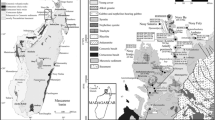Abstract.
The intrusive complexes of Gremiakha-Vyrmes and Soustov represent the two extremes of the Early Proterozoic alkaline plutons of Kola, predominantly composed of feldespathoidal syenites. Gremiakha-Vyrmes rocks (zircon age: 1,884±6 Ma) have trace-element and isotope signatures (87Sr/86Srt≈0.704, εNdt≈–3–1.3) compatible with an ultimate mantle origin. Soustov syenites (zircon age: 1,872±8 Ma) are totally different and show an acute crustal imprint. They have sodaline and analcite instead of nepheline, contain a plethora of REE-HFSE-rich accessories, and are characterised by elevated contents of F, Cl, REE, Y, Th, U, Zr, Hf, Nb, Ta, Sn, Be, Li, Rb, Tl, Pb and Cs, negative Eu anomalies, K/Rb≈190–160, Nd/Th≈3, and Nb/Ta≈12, with extremely high 87Sr/86Srt (>0.720) and, at the same time, relatively high εNdt (≈–1.6–1.7). In this paper, we explore the idea that the anomalous features of Soustov syenites can be explained if we assume they are derived from a metasomatic agent, initially an H2O-CO2 supercritical fluid released by alkaline mafic magmas, that was profoundly contaminated during percolation through crustal materials. As percolation advanced, the bulk composition of the fluid solute changed from alkali halides and carbonates to a silica-undersaturated alkaline melt. When the fluid cooled to a temperature of ~550–600 °C, it reached the point at which vapor and melt were no longer miscible and split into two components, a vapour phase and a Cl- and F-rich silica-undersaturated silicate melt that crystallised to produce Soustov syenites. To study this process, we have developed a numerical method for modelling the solute composition of the fluid during the infiltration metasomatism. Our results, using the LREE abundances and the Sr and Nd isotope composition of a Gremiakha-Vyrmes pegmatite as the starting solute composition of the fluid, and the mode and mineral trace-element and isotope composition of a common Kola gneiss as representative of percolated materials, indicate that the fluid would have acquired a signature closely matching Soustov's, even in the case of Nd isotopes, if the gneiss age is 2.9 Ga, near its real age. This model is still a mere working hypothesis that needs further refinements, but may represent a reasonable explanation of the genesis of anomalous alkaline rocks with high 87Sr/86Srt and εNdt≥0, either saturated or undersaturated, which are difficult to understand in terms of magmatic fractionation/contamination.
Similar content being viewed by others
Author information
Authors and Affiliations
Additional information
Electronic Publication
Rights and permissions
About this article
Cite this article
Bea, .F., Arzamastsev, .A., Montero, .P. et al. Anomalous alkaline rocks of Soustov, Kola: evidence of mantle-derived metasomatic fluids affecting crustal materials. Contrib Mineral Petrol 140, 554–566 (2001). https://doi.org/10.1007/s004100000211
Received:
Accepted:
Issue Date:
DOI: https://doi.org/10.1007/s004100000211




